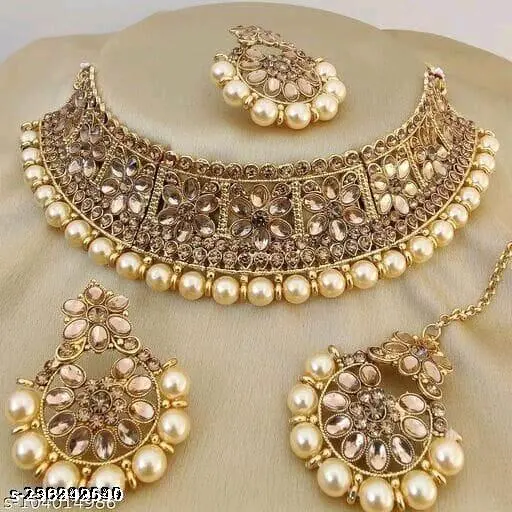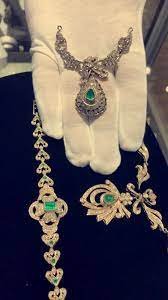The Timeless Elegance of Traditional Jewelry: A Journey Through History and Culture
Jewelry has always been more than mere adornment; it carries deep cultural significance, historical value, and a personal touch that transcends generations. Traditional jewelry, in particular, is a reflection of the rich heritage and craftsmanship of various cultures around the world. In this blog, we’ll embark on a journey through some of the most iconic traditional jewelry styles, exploring their history, significance, and enduring appeal.
1. Indian Traditional Jewelry: A Symphony of Craftsmanship
Indian traditional jewelry is renowned for its opulence and intricate designs. Each piece tells a story, often associated with specific ceremonies or regions.
Kundan and Polki: These styles involve setting precious stones in gold. Kundan, with its glass stones and elaborate designs, was popular among the Mughal emperors, while Polki, which uses uncut diamonds, offers a raw, unpolished elegance.
Meenakari: This technique involves enameling on metal, creating vibrant, colorful designs that often feature floral or geometric patterns.
Temple Jewelry: Originally crafted for deities in temples, this jewelry is characterized by its heavy gold, intricate designs, and religious symbolism.

2. African Traditional Jewelry: A Symbol of Identity and Status
African traditional jewelry is as diverse as the continent itself, with each region offering unique styles and meanings.
Beaded Necklaces: In many African cultures, beads are more than just decorative elements; they symbolize social status, age, and tribal affiliation. For example, the Maasai people use brightly colored beads to signify different stages in life.
Cowrie Shells: Historically used as currency, cowrie shells are now prominently featured in jewelry, representing wealth and fertility.
Bronze and Copper Jewelry: In West Africa, bronze and copper pieces are often associated with royalty and high status. These metals are used to create elaborate pieces with symbolic meanings.

3. Middle Eastern Traditional Jewelry: A Blend of Elegance and Mystique
Middle Eastern traditional jewelry is known for its intricate designs and luxurious materials.
Bedouin Jewelry: This style often features large, elaborate pieces made from silver and adorned with colorful stones. The designs are rich with symbolism and reflect the nomadic lifestyle of the Bedouin people.

Persian Jewelry: Persian pieces often include elaborate filigree work and are sometimes set with turquoise and other gemstones. The intricate patterns and use of enamel reflect the sophistication of Persian art.

Arabic Jewelry: Arabic designs often incorporate calligraphy and geometric patterns, showcasing the region’s rich artistic heritage and love for intricate craftsmanship.

4. East Asian Traditional Jewelry: Harmonious and Symbolic
Traditional jewelry in East Asia often incorporates elements of nature and spirituality.
Chinese Jewelry: Chinese traditional jewelry is known for its use of jade, which symbolizes purity and harmony. Pieces like the Pi Xiu (a mythical creature) and gold ingots are believed to bring good fortune.

Japanese Jewelry: Traditional Japanese jewelry often features designs inspired by nature, such as cherry blossoms or waves. The art of Kimonos also extends to jewelry, with intricate patterns and delicate craftsmanship.

Korean Jewelry: Korean traditional jewelry, such as the Binyeo (hairpin) and Norigae (pendant), often features elaborate designs and is used in traditional ceremonies like weddings.

5. South American Traditional Jewelry: Vibrant and Diverse
South American traditional jewelry is deeply connected to indigenous cultures and their rich histories.
Inca Jewelry: Known for its use of gold and intricate metalwork, Inca jewelry often includes symbolic motifs related to nature and spirituality.
Amazonian Jewelry: Indigenous tribes of the Amazon create jewelry using natural materials like feathers, seeds, and bones, reflecting their deep connection to the environment.
Colombian Emerald Jewelry: Colombia is famous for its emeralds, and traditional jewelry often features these precious stones set in elaborate designs.
Conclusion
Traditional jewelry is a testament to the artistic and cultural richness of human history. Each piece is not just a beautiful accessory but a symbol of the values, beliefs, and skills of the people who created it. As we appreciate the timeless elegance of these jewelry styles, we also celebrate the diverse cultural heritage that they represent. Whether you are drawn to the intricate designs of Indian jewelry, the vibrant colors of African beads, or the symbolic elements of East Asian pieces, traditional jewelry offers a window into the past and a connection to the present.
Embrace the beauty and history of traditional jewelry, and let these exquisite pieces add a touch of timeless elegance to your collection.





Mashallah nice jewelry
Thanks
your blog is very nice
good blog
Superb 👍🙌
Nice Jewerly
Nice 🙂
Nic5
Nice
your blog post is very nice
Beautiful ❤️
Mashallah nice jewelry
Nice
Superb👍🤲👐
kkkkkkkk
hgggggggg